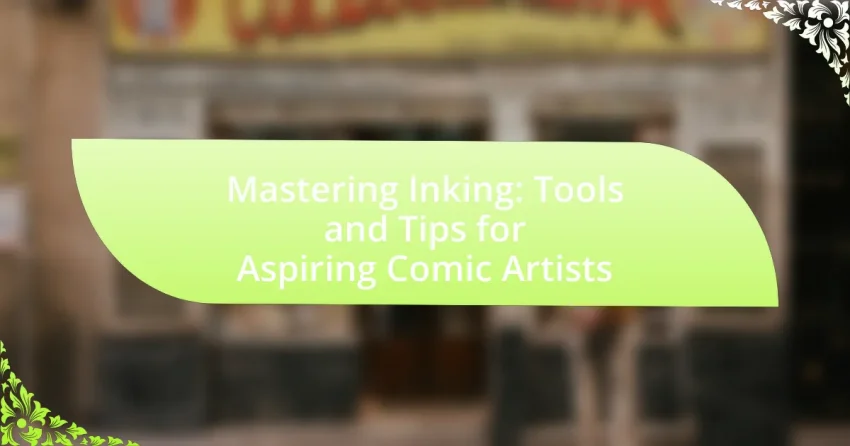The article “Mastering Inking: Tools and Tips for Aspiring Comic Artists” focuses on the essential process of inking in comic art, which involves applying ink to pencil drawings to enhance visual clarity and depth. It outlines the differences between inking and other comic art techniques, emphasizing its significance in storytelling and character development. Key topics include the tools required for effective inking, such as pens and brushes, techniques to improve inking skills, and common mistakes to avoid. The article also highlights the importance of mastering inking for aspiring artists to enhance their marketability and develop a unique style.

What is Inking in Comic Art?
Inking in comic art is the process of applying ink to pencil drawings to create defined lines and enhance visual clarity. This technique is essential for producing the final artwork, as it adds depth, contrast, and texture, making the illustrations suitable for printing and publication. Historically, inking has been performed using various tools such as brushes, pens, and markers, which allow artists to achieve different styles and effects. The significance of inking is underscored by its role in the comic book industry, where the quality of inked artwork can greatly influence the overall appeal and readability of the comic.
How does inking differ from other comic art techniques?
Inking differs from other comic art techniques primarily in its focus on defining and enhancing line work, which is essential for creating contrast and depth in illustrations. Unlike sketching, which emphasizes rough outlines and initial concepts, inking involves the application of precise, bold lines that solidify the artwork’s final appearance. Additionally, inking often utilizes specific tools such as brushes and pens, which allow for varied line thickness and texture, setting it apart from coloring techniques that focus on hue and shading. The historical significance of inking is evident in its role in comic book production, where it has been used since the early 20th century to produce clean, reproducible images that are essential for printing.
What are the primary purposes of inking in comics?
The primary purposes of inking in comics are to enhance the visual clarity, define shapes and forms, and establish mood and tone. Inking solidifies the pencil work by adding depth and contrast, making the artwork more legible and visually appealing. Additionally, ink can convey emotions and atmosphere through varying line weights and styles, which can significantly impact the reader’s experience. Historical practices in comic art, such as the use of different inking techniques by artists like Jack Kirby and Will Eisner, demonstrate how inking contributes to storytelling and character development.
How does inking enhance the storytelling in comics?
Inking enhances storytelling in comics by adding depth, clarity, and emotional impact to the artwork. The use of varied line weights and textures allows artists to emphasize important elements, guide the reader’s eye, and convey mood. For instance, thicker lines can denote strength or focus, while thinner lines may suggest fragility or detail. This technique not only improves visual hierarchy but also reinforces narrative themes, as seen in works like “Watchmen” by Alan Moore and Dave Gibbons, where inking plays a crucial role in establishing tone and atmosphere.
Why is mastering inking important for aspiring comic artists?
Mastering inking is crucial for aspiring comic artists because it significantly enhances the visual quality and clarity of their artwork. Inking defines the final look of comic panels, providing depth, contrast, and emphasis on characters and scenes. High-quality inking can elevate a comic’s storytelling by guiding the reader’s eye and establishing mood through line weight and texture. Furthermore, professional comic publishers often prioritize artists with strong inking skills, as it is essential for producing polished, publishable work. Thus, mastering inking not only improves artistic proficiency but also increases marketability in the competitive comic industry.
What skills does inking develop in comic artists?
Inking develops precision, attention to detail, and an understanding of line quality in comic artists. These skills are essential for creating clean, professional-looking artwork that effectively conveys the intended mood and action of the story. Precision is crucial as it allows artists to execute intricate designs and maintain consistency throughout their work. Attention to detail enhances the overall quality of the artwork, ensuring that every element contributes to the narrative. Understanding line quality helps artists manipulate thickness and texture, which can significantly impact the visual storytelling.
How does inking contribute to an artist’s unique style?
Inking significantly contributes to an artist’s unique style by allowing for the expression of individual techniques and preferences in line quality, texture, and shading. The choice of tools, such as brushes or pens, influences the thickness and fluidity of lines, which can create distinct visual signatures. For instance, artists like Frank Miller utilize heavy inking to evoke a gritty atmosphere, while others, like David Mazzucchelli, may favor finer lines for a more delicate appearance. This variation in inking techniques not only defines the aesthetic of the artwork but also enhances storytelling by conveying mood and depth, thereby solidifying the artist’s identity within the comic art community.

What Tools are Essential for Inking?
Essential tools for inking include high-quality ink pens, brushes, and paper. Ink pens, such as fine liners and brush pens, provide precision and control for detailed work. Brushes, particularly those made from sable or synthetic fibers, allow for varied line thickness and texture. Additionally, smooth, heavyweight paper is crucial for preventing ink bleed and ensuring clean lines. These tools are widely recognized in the comic art community for their effectiveness in achieving professional results.
What types of pens and brushes are commonly used for inking?
Commonly used pens for inking include dip pens, brush pens, and fineliners. Dip pens, which utilize ink reservoirs and interchangeable nibs, allow for varied line thickness and are favored for their precision. Brush pens, equipped with flexible bristles, enable artists to create dynamic strokes and are popular for their versatility in line work. Fineliners, characterized by their consistent ink flow and fine tips, are ideal for detailed illustrations and clean lines. These tools are essential for comic artists, as they provide the necessary control and variety in line quality required for effective inking.
How do different pen types affect the inking process?
Different pen types significantly affect the inking process by influencing line quality, ink flow, and overall artistic expression. For instance, fountain pens provide a smooth ink flow and varying line widths based on pressure, allowing for expressive strokes, while gel pens offer vibrant colors and consistent ink delivery, ideal for detailed work. Conversely, technical pens deliver precise lines with consistent ink flow, making them suitable for intricate designs. Each pen type’s nib design and ink viscosity directly impact how ink adheres to paper, affecting drying time and smudging potential. Research indicates that artists often choose pen types based on the desired effect and medium, highlighting the importance of selecting the right tool for specific artistic goals.
What are the advantages of using brushes over pens?
Using brushes offers several advantages over pens, particularly in the context of comic art. Brushes provide a greater range of line variation, allowing artists to create both fine details and broad strokes within a single tool. This versatility enhances the expressive quality of the artwork, enabling smoother transitions and dynamic textures that pens often cannot achieve. Additionally, brushes can hold more ink, which allows for longer drawing sessions without frequent re-inking, thus improving efficiency. The fluidity of brush strokes can also contribute to a more organic and lively appearance in illustrations, making them preferable for artists aiming for a more dynamic style.
What other tools can enhance the inking experience?
Various tools can enhance the inking experience, including high-quality pens, brushes, and digital tablets. High-quality pens, such as Micron or Copic Multiliner, provide precision and consistent ink flow, which is essential for detailed work. Brushes, particularly those made with synthetic or natural bristles, allow for varied line thickness and texture, enhancing artistic expression. Digital tablets, like those from Wacom or Huion, offer the flexibility of undoing mistakes and experimenting with different styles without the permanence of traditional ink. These tools collectively improve the quality and efficiency of the inking process, making them invaluable for aspiring comic artists.
How do inks and paper types influence the final artwork?
Inks and paper types significantly influence the final artwork by affecting color vibrancy, texture, and overall visual impact. Different inks, such as water-based or oil-based, yield varying levels of saturation and drying times, which can alter the appearance of colors on the page. For instance, water-based inks tend to produce softer colors, while oil-based inks offer richer, more intense hues.
Moreover, the choice of paper impacts how ink interacts with the surface; smooth papers allow for finer detail and crisp lines, while textured papers can create a more organic feel and absorb ink differently, leading to variations in line quality and shading. Research indicates that the combination of specific ink types and paper textures can enhance the depth and dimensionality of artwork, as seen in studies on printmaking techniques. Thus, selecting the appropriate ink and paper is crucial for achieving the desired aesthetic in comic art.
What role do light tables and rulers play in inking?
Light tables and rulers are essential tools in the inking process for comic artists. Light tables allow artists to trace over pencil sketches with precision, ensuring that the final inked lines maintain the intended details and proportions. Rulers provide straight edges for creating clean lines and consistent borders, which are crucial for achieving a professional look in comic panels. The combination of these tools enhances accuracy and efficiency, enabling artists to produce high-quality inked artwork that aligns with their creative vision.

What Techniques Can Improve Inking Skills?
To improve inking skills, artists should practice line control, utilize various inking tools, and study the work of established inkers. Line control can be enhanced through consistent practice, focusing on varying line thickness and pressure to create depth and texture. Using different tools, such as brushes, pens, and markers, allows artists to discover their preferred methods and styles, as each tool produces distinct effects. Additionally, analyzing the techniques of accomplished inkers, such as their use of shadows and highlights, can provide valuable insights and inspire personal growth in inking abilities.
How can aspiring artists practice their inking techniques?
Aspiring artists can practice their inking techniques by regularly using various inking tools, such as brushes, pens, and markers, to create different line weights and textures. Consistent practice with these tools allows artists to develop control and precision, which are essential for effective inking. Additionally, studying the work of established inkers and replicating their techniques can provide valuable insights into effective inking styles and methods. Engaging in exercises like inking over pencil sketches or creating original line art can further enhance an artist’s skills.
What exercises are effective for developing line control?
Exercises effective for developing line control include straight line drills, curve exercises, and varying pressure techniques. Straight line drills involve repeatedly drawing straight lines to enhance stability and precision. Curve exercises focus on creating smooth arcs and circles, which improve fluidity in line work. Varying pressure techniques, such as applying different amounts of pressure while drawing, help artists learn to control line thickness and create dynamic effects. These exercises are widely recommended in art education and practice, as they build foundational skills essential for inking in comic art.
How can artists learn to create varied line weights?
Artists can learn to create varied line weights by practicing different pressure techniques with their drawing tools. By applying more pressure on the tool, artists can produce thicker lines, while lighter pressure results in thinner lines. This technique is supported by studies in art education, which emphasize the importance of hand control and pressure application in achieving line variation. Regular exercises, such as drawing lines with varying pressure and experimenting with different tools like brushes and pens, can enhance an artist’s ability to manipulate line weight effectively.
What common mistakes should artists avoid when inking?
Artists should avoid common mistakes such as inconsistent line weight, neglecting to plan their compositions, and using the wrong tools for inking. Inconsistent line weight can lead to a lack of depth and visual interest in the artwork, as varying thicknesses help to create emphasis and dimension. Failing to plan compositions can result in awkward layouts and poor visual storytelling, which are critical in comic art. Additionally, using inappropriate tools, such as brushes or pens that do not suit the desired effect, can compromise the quality of the final piece. These mistakes can hinder an artist’s ability to effectively convey their vision and connect with their audience.
How can over-inking affect the overall artwork?
Over-inking can negatively impact the overall artwork by creating excessive darkness and obscuring details. This can lead to a loss of contrast, making elements of the artwork appear flat and less dynamic. Additionally, over-inking can cause smudging and bleeding, which detracts from the clean lines that are essential in comic art. Studies in visual perception indicate that excessive ink can overwhelm the viewer’s eye, reducing the effectiveness of the artwork’s intended message and emotional impact.
What are the signs of poor inking techniques?
Signs of poor inking techniques include inconsistent line weight, uneven ink distribution, and smudging. Inconsistent line weight occurs when the thickness of lines varies unpredictably, which can detract from the overall aesthetic of the artwork. Uneven ink distribution manifests as blotchy areas or streaks, indicating a lack of control over the inking tool. Smudging often results from using the wrong type of ink or paper, leading to unintended marks that compromise the clarity of the artwork. These signs collectively indicate a need for improvement in the artist’s inking skills.
What are some best practices for successful inking?
Successful inking requires precision, consistency, and the right tools. To achieve high-quality results, artists should use a variety of inking pens, including brush pens and fine liners, to create different line weights and textures. Maintaining a steady hand and practicing control over pressure can enhance line quality. Additionally, artists should ensure their workspace is well-lit and organized to facilitate focus and efficiency. Regularly cleaning tools and using high-quality ink can prevent smudging and ensure longevity of the artwork. These practices are supported by professional artists who emphasize the importance of technique and tool selection in achieving polished inked illustrations.
How can artists maintain their tools for optimal performance?
Artists can maintain their tools for optimal performance by regularly cleaning, properly storing, and periodically inspecting their equipment. Regular cleaning prevents the buildup of ink and debris, which can affect the quality of the work; for instance, using appropriate solvents for brushes and nibs ensures longevity and functionality. Proper storage, such as keeping pens upright and away from extreme temperatures, protects tools from damage. Periodic inspection allows artists to identify wear and tear early, enabling timely repairs or replacements, which is crucial for maintaining consistent performance in their artwork.
What tips can help artists develop a consistent inking style?
To develop a consistent inking style, artists should practice regularly with various tools to understand their effects and limitations. Consistent practice helps artists refine their technique and build muscle memory, which is crucial for maintaining a uniform style. Additionally, studying the work of established artists can provide insights into different inking styles and techniques, allowing artists to identify elements they wish to incorporate into their own work. Keeping a sketchbook dedicated to inking experiments can also facilitate exploration and help artists track their progress over time.
